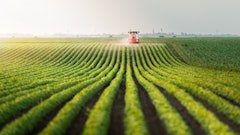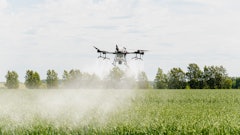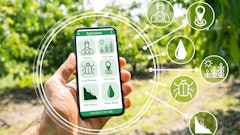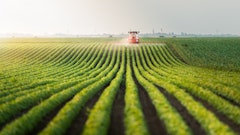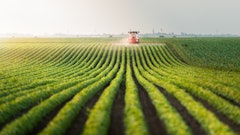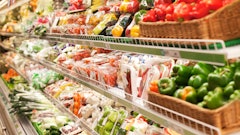
With the average age of farmers currently standing at 58, today marks an inflection point for real change that will inform the future agriculture sector. Through education and technology, the impact will enable a full end-to-end supply chain that will offer tangible benefits to quick service restaurants. one that will impact not only their own operations, but indeed, enable a full end-to-end supply chain.
Current situation
The time is now to modernize the food supply chain for the next generation. The good news is, the future has already begun. Currently, a tweak in labeling by deploying RFID technology adds a digital connection to the analog data already contained on labels applied at the farm. Deploying this intelligent solution is not a revolutionary technology implementation and does not require significant disruption to existing processes. However, the benefits that unfold are the beginning of a bigger story in the food supply chains and consumer-facing operations.
The goal – that is currently being met in a pilot program with 20 farms around the United States – is to implement a solution with RFID that provides traceability from the farm all the way to the food retailer. The benefits of traceability flow through every aspect of operations encompassing labor allocation, inventory tracking, freshness, and expiry, as well as forecasting.
Why is traceability so essential?
Let’s start at the very end of the supply chain: Customers. Consumers have been clamoring for information about where their food is coming from for some time now. So, with digital identification starting at the farm, food retailers can provide that information with total accuracy.
Even before the food gets to the restaurant or grocery, operators can view the trajectory of each carton of ingredients, across the entire network: farm, processor, distribution center and all points ending at the restaurant or store. Being able to have visibility on travel, dwell time and other factors, allows the retailer to know exactly how fresh their farm goods are.
Inventory and labor allocation
Visibility to ensure accurate real-time inventory data as it flows through the different parts of the supply chain allows operators to drive much better decisions. At the restaurant or store, accuracy starts with early morning scans, but does not end with it.
When a shipment from a farm is received into the sales venue, the challenge becomes inventory control. Every case must be accurately scanned in, but with manual scans, the process can be 20-30 minutes and still only achieve 80% accuracy. Repeating the barcode scanning process may produce greater accuracy, but it obviously requires additional time. It is time-consuming and arduous for both the person doing the scanning and the operations manager.
With RFID, the process of logging inventory is done in just a few seconds via handheld scanning to instantly read all cases. The time savings is clear, especially since the process is truly as simple as click and scan to read all cases in mere seconds. It is especially important as the labor pool in the U.S. continues to remain static.
The corporate question
At the corporate level for food businesses, it has become vital to introduce tools and technologies that streamline people's work and make it quicker and easier to do, like RFID. Re-allocation of labor affects not only labor hours, but it can also have a positive impact on inventory planning and ordering. In fact, the instantaneous, precise data generated for real-time restaurant inventory has great value for the corporate data analytics team to see how inventory is flowing through the system.
Sometimes food businesses spend millions of dollars implementing demand planning systems, supply planning systems, predictive analytics, and others. But often the data is wrong at the outset because there is no real time information available on the food operation’s inventory. If all those systems are based on flawed data, errors may increase exponentially across the supply chain.
Despite all the algorithms, accuracy starts with knowing exactly what's happening across the supply chain, at every level. The ability to generate more accurate data is simply more productive.
ESG goes back to the farm
Close to $163 billion worth of food inventory globally is discarded each year due to expiry or overproduction. Often environmental, social, governance (ESG) is considered independent from the economics of running a business, but when you look at the problem of recalls, ESG is the business.
Food retail operators still shudder at the memory of 2018, when each one around the country got a missive from the FDA that ordered all romaine lettuce to be taken out of foodservice and in retail as well. The national recall mandated that it all had to be thrown out.
Restaurant and retail crews had to scramble to figure out how to throw all of it away while tens of millions of dollars of food was wasted across the country. Months later, the FDA issued a report with further detail on what had happened: the food safety issue was traced back to just one farm!
With RFID technology, identifying the exact contaminated case could have been quickly accomplished, so only the romaine lettuce from that one farm would have needed to be discarded. Its travel across the supply chain would have been documented and business operators could say for certain which lot needed to be removed and a huge source of waste would have been avoided.
This ability to gain surgical precision through traceability during recall events is a major ESG objective for food supply chains and it all starts with accurate data.
Empowering the farmer
Start by looking at how RFID technology deployed at the farm reaps benefits across the supply chain into grocers and restaurants through accurate data for traceability and visibility. Farmers have the hardest job and least empowerment right now. Let’s explore how data will enable them in the future.
The two major elements in the food supply chain that cause food waste are 1) making too much or 2) not using it fast enough. Tomorrow’s farmers will be empowered to control some aspect of their supply chain and control freshness through visibility. Specifically, as a farmer, if you know what you’re selling and are selling what you need with the right amount of freshness, you can do a better job of tying production to consumption patterns. In turn, this ensures the maximum amount of food is being sold before it goes to waste.
The new generation of farmers is looking to technology to be able to run their agricultural business operations better and more profitably. Farmers are taking advantage of new educational opportunities, some even driven by the industry.
As they adopt newer technologies, patterns of buying plus predictive analytics will better inform what food businesses need to buy. More accurate data will help farmers plan their harvests and the information obtained via RFID digital solutions is data that farmers might use to optimize their own operations.
In the new scenario, there is a strong case for farmers to use this data. Today, farmers are enabling RFID for grocery and restaurants, but tomorrow’s farmers are asking what’s in it for them? Democratization of the data so that farmers can access it is a win-win across the supply chain. In the future, farmers will utilize the data to enable greater sustainability, as well as to proactively provide their own freshness information to their retail customers. Owning and leveraging their own farm-level data makes the next generation of farmers a stronger food logistics partner.



